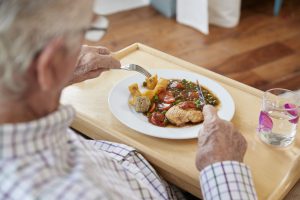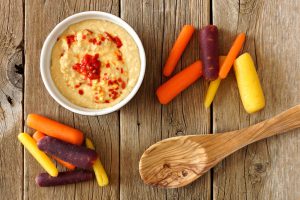Illness can change your loved one’s appetite and ability to eat,
but as a caregiver, you can help

Eating is essential to our lives. We derive pleasure from the food we eat, as well as sustenance. Good food brings joy, elicits wonderful memories, and often plays a key role in marking important milestones.
Preparing and serving food for loved ones is an expression of love. But what happens when your loved one reaches another milestone – nearing the end of life? And he or she is seriously ill and is having difficulty eating and drinking? Continue reading to learn how you can maintain your loved one’s physical and emotional comfort while addressing the change in end-of-life nutrition.
Read more: Is Your Loved One Eligible for Hospice Care?
End-of-Life Nutrition
When you become ill with something minor such as a cold, flu, sprained wrist, or headache, your appetite can decrease. Imagine when you or someone you love becomes seriously ill and approaches the end of life. Not only do they not feel well, but their body’s need for food and end-of-life nutrition changes due to decreased activity and metabolic changes.
Plus, they may experience symptoms that will reduce their appetite, such as nausea and pain. Their disease can also affect their taste buds, making food taste bland, salty, or sour. Some medications may also alter flavors and appetite.
Concern for your loved ones’ appetite and discomfort with food can cause eating and food to become a stressful and contentious event. It is important to remember that you don’t want to close the lines of communications with your loved one so that they stop communicating how they are feeling. You are on the same team, both aiming for the same goal of maximizing their comfort.
What Can a Hospice Patient Eat and Drink?
Anything that he or she wishes.
________________________________
If you live in South Jersey and have questions about hospice care, please call us at (856) 596-1600.
________________________________

Avoid the Food Struggle: Withholding Nutrition at the End of Life
Hospice experts advise families to avoid such a “food struggle” by allowing your loved one to eat what they want when they want. Withholding nutrition at the end of life and not eating can actually help reduce discomfort from a weakened digestive system.
What causes a decreased appetite in hospice patients?
- Nausea and vomiting.
- Constipation.
- Bowel tumors and/or obstruction.
- Liver and pancreatic cancer.
- Pain.
- Weakness and fatigue.
- Medications, narcotic and non-narcotic.
- Chemotherapy/radiation.
- Bleeding gums and/or dental problems.
Priorities can change when your loved one is facing a terminal illness. It’s important to spend time doing other activities and building relationships, rather than having the food struggle.
Let your loved one make food choices; their body knows what it needs.
Your loved one’s wishes, dignity, and comfort should be the guide.
With that said, you can help your loved one want to eat, and enhance access to the comforts of food and drink. If the doctor recommends a specific diet, follow it as much as possible. And feel free to discuss these issues with the hospice team.
________________________________
If you live in South Jersey and have questions hospice care, please call us at (856) 596-1600.
________________________________
What to do when your loved one doesn’t want to eat at the end of life

Here are some simple tips to help encourage (but not compel) your loved one to eat:
- Offer small, frequent meals throughout the day, rather than keeping a three-meal-a-day routine.
- Serve small portions, so your loved one doesn’t feel overwhelmed or have a sense of failure because they can’t clean their plate.
- Serve meals when your loved one is pain-free and has the most energy, such as morning, mid-afternoon, and after pain medication.
- Make high-calorie snacks/supplements available at all times. Be sure to follow the manufacturer’s instructions for storage and handling of supplements.
- Limit use of low-calorie foods and drinks, such as broths, coffee and tea.
- Offer frequent sips of favorite liquids. A travel mug with a lid or a closed container with a straw allows a weak person to drink independently without worry or spills.
- Instant breakfast mixes can serve as a meal.
- When your loved one no longer wants to eat or drink, offer ice chips — flavored and unflavored – to relieve feelings of dryness and discomfort.
- Remember, as your loved one’s condition progresses, their appetite will decrease substantially.
- Do not force foods.
In addition, to increase the patient’s calorie intake:
- Serve higher-calorie, nutrient-dense foods, such as full-fat dairy products, avocado, and peanut butter/nut butters.
- Use calorie-rich supplements.
- Add melted butter, olive oil, or margarine to foods.
Strive for a balanced diet if possible, including protein, fat, and carbohydrates. Protein, which is the building block of tissue, reduces the chance of getting pressure sores. If the patient is consuming little or no protein, here are ways to add it to their diet:
- Add grated cheese to sauces, casseroles, and vegetables.
- Provide high-protein snacks between meals. These can include eggs, peanut butter/nut butters, cheese, Greek yogurt, cottage cheese, canned tuna, meat, poultry, and over-the-counter protein drinks
When Your Loved One Has Difficulty Chewing or Swallowing

Serve soft, non-irritating foods for meals and snacks:
- Puree family meals in a blender.
- Soak foods in gravy, broth, or milk.
- Serve baby foods. Try making them more appetizing with spices and seasonings.
- Avoid dry, crisp, and hard foods.
- Avoid spicy and acidic foods. Acidic foods include tomatoes, tomato sauces, citrus fruits, and foods made with vinegar.
- Avoid temperature extremes in foods – nothing very hot or very cold.
- Use liquid supplements.
Tips to Manage Nausea
- Encourage your loved one to eat more when feeling better.
- Reschedule meals if nausea occurs frequently at the same time of day.
- Serve saltier foods.
- Avoid very sweet foods.
- Avoid greasy foods.
- Offer small, frequent, light meals/snacks, bland foods, gelatin and puddings. Cold foods are often more appealing than hot.
- Encourage the patient to chew food thoroughly and eat slowly.
- Serve fluids between, instead of with, meals.
- Liquid meals are often best when the person is nauseated or in pain. For example, offer soups, smoothies, shakes, yogurt, ice cream, and cool drinks.
- Try sports drinks, popsicles, cola syrup, and peppermints. Freeze juice in ice-cube trays.
- Give the patient anti-nausea medications as directed.
- Have the patient avoid lying flat after eating.
Tips to Manage Diarrhea
- Take medication as ordered.
- Notify the nurse if diarrhea is continuous for more than 6 – 8 hours.
- Increase fluid intake, but avoid fruit juice or milk. Sports drinks may be used.
- Serve small, frequent amounts of rice, rice cereal, banana, and applesauce. Toast can be added to the diet as tolerated.
- Limit greasy, fatty, and fried foods.
- Avoid foods and drinks containing caffeine.
- Avoid large amounts of sweets and sorbitol-sweetened products.
- If cramping is a problem, avoid “gas-producing” foods such as carbonated beverages, beans, cabbage, cauliflower, and broccoli.
- Apply petroleum jelly to sore area of your loved one’s bottom, as ordered.
A Positive View: Benefits of Withholding Food & Drink at the End of Life

Lack of eating and drinking can increase comfort near the end of life because
- Food and fluids can cause bloating, nausea, vomiting, and diarrhea.
- Fluids increase the amount of urine, which may require insertion of a urinary catheter or painful movement to a bedpan.
- If the person is incontinent, they may experience discomfort from being cleaned and having their bedding changed.
Each person’s situation is different, and the hospice team can help you make the best decisions for your loved one’s comfort and dignity.
Honoring Wishes
Remember, never force end-of-life nutrition or insist that your loved one eat. This can develop into a struggle where the family feels rejected and your loved one feels ungrateful or guilty. Your loved one may even give in, to some degree, but may feel worse both physically and emotionally, and the family relationship could suffer.
As a caregiver, you shouldn’t worry about withholding nutrition at the end of life. Make it easier and more inviting by following the tips provided above. Your loved one’s wishes, dignity, and comfort should be the guide.
